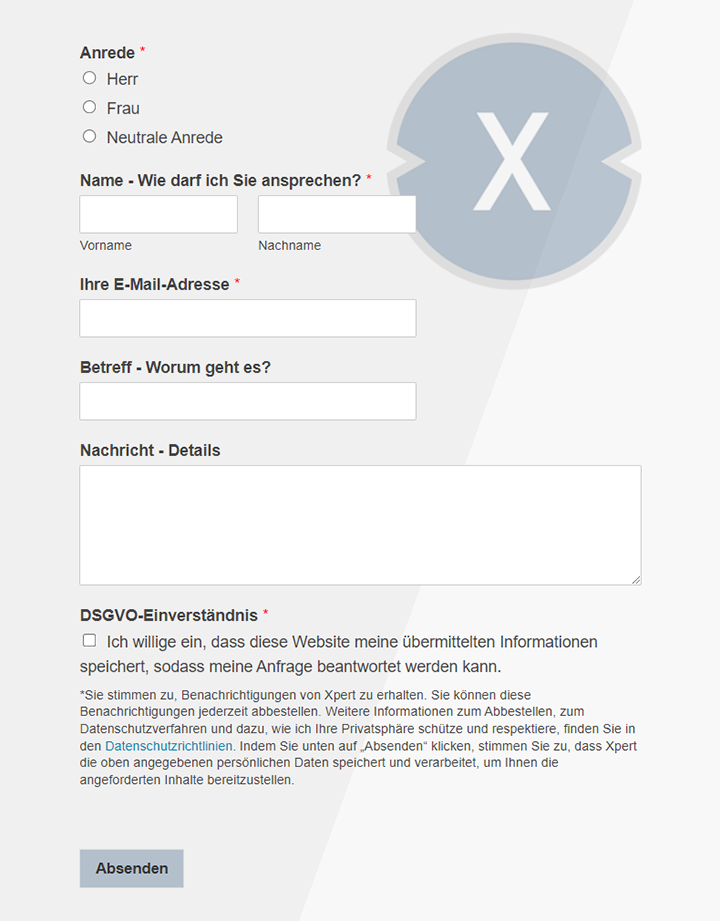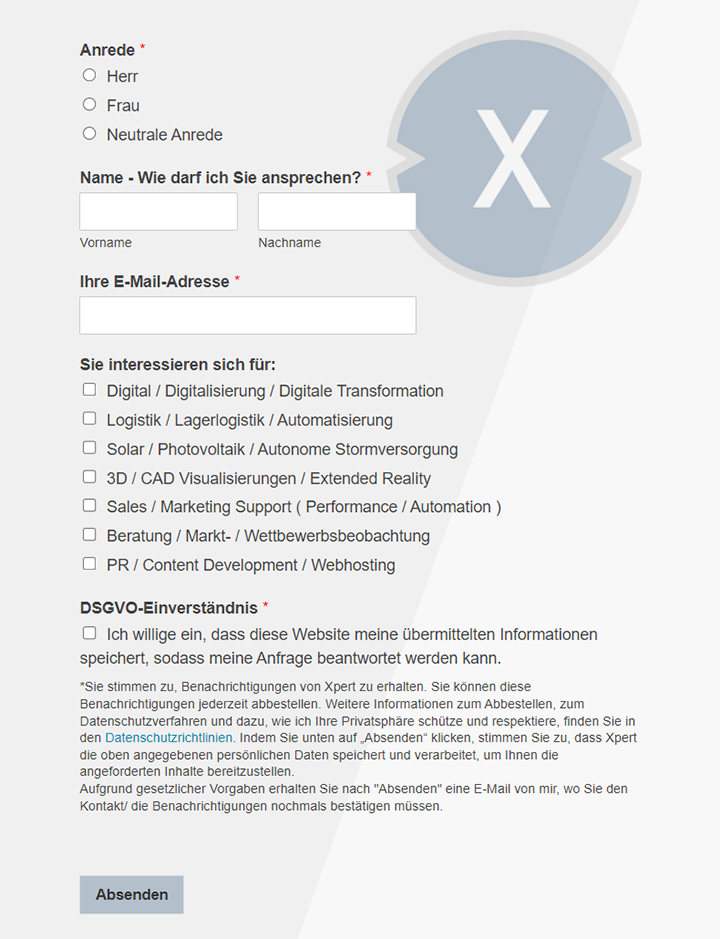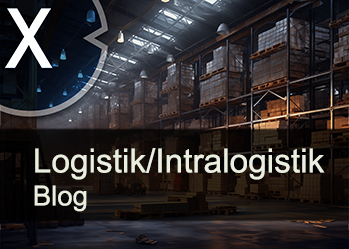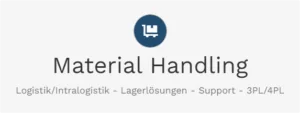Hybrider, multimodal logistics traffic (road rail) in Germany with civil-military double use
Xpert pre-release
Language selection 📢
Published on: April 23, 2025 / update from: May 1, 2025 - Author: Konrad Wolfenstein

Hybrider, multimodal logistics traffic (road rail) in Germany with civil-military double use-Image: Xpert.digital
Dual -use infrastructure for economy and defense - strategies for a hybrid transport system - security meets efficiency, hits military resilience (reading time: 46 min / no advertising / no paywall)
Strategic logistics suggestions for a hybrid, multimodal combined street rail traffic in Germany taking into account civil-military double use
Germany faces a double strategic challenge: as a central logistics hub in Europe and as a decisive turntable for NATO, especially in the context of the Host Nation Support (HNS) and the defense of the eastern flank, the country must have a high -performance and resilient transport infrastructure. At the same time, current analyzes reveal significant deficits and bottlenecks in the existing network, which affect both civilian economic activity as well as military operational readiness and reaction. The renewed focus on state and alliance defense (LV/BV) in the course of the "time turning" underlines the urgency to address these weaknesses.
This article presents strategic suggestions for the development of a hybrid, multimodal logistics system that focuses on combined traffic (KV) street rail. The core concept is based on a dual-use infrastructure: Critical KV systems (terminals, route sections, loading facilities) are primarily financed by means of defense, which are provided under the heading "Securing defense and defense logistics". However, this infrastructure is designed from the start in such a way that it can be used efficiently by civil logistics players in non-emergency times.
The analysis shows considerable deficits in the state of the German rail network, especially for bridges, signal boxes and highly stressed sections of the route, despite the first signs of improvement and ongoing modernization programs such as "general renovation". The KV market has considerable growth potential and is essential for relocation, but suffers from these infrastructure defects and capacity shortages. Military transports face specific challenges: bureaucratic hurdles, limited capacities for heavy load transports (missing flat wagons, limited contracts with DB cargo) and an infrastructure that often does not meet military requirements (e.g. military load class - MLC). Financing options consist of national defense budgets, potentially flanked by EU funds (e.g. CEF Military Mobility), whereby civil cost sharing is sought through usage fees. The tense situation of DB Cargo also requires the examination of alternative operator models, including private lanes.
The central recommendations include the prioritized upgrading of selected KV terminals and rail corridors for dual-use operation taking into account military standards (MLC, security, charging capacities for military vehicles). The creation of a clear legal and operational framework for hybrid operation is proposed, which ensures military prioritization if necessary and at the same time enables reliable civil use. Financing should be strategically through a combination of national defenses and EU programs. The development of pilot projects on strategically relevant corridors (e.g. towards Eastern Europe) with the integration of all relevant stakeholders (BMVG, BMDV, Bundeswehr, DB Infrago, private operator) is recommended to gradually demonstrate and implement the model gradually.
Suitable for:
- Military logistics 4.0: The future of military supply chains - automation and civilian infrastructure as strategic factors for NATO (reading time: 34 min / no advertising / no paywall)
Strategic imperative: the need for a hybrid street-schiene logistics
Double need: strengthening defense logistics and civilian supply chain efficiency
The need for a robust and efficient logistics infrastructure in Germany results from two complementary strategic requirements: the increased military needs within the framework of the state and alliance defense as well as the continuing civility requirements according to efficient and sustainable transport routes.
From a military point of view, the changed security situation in Europe, especially since Russian aggression against Ukraine, requires a significant increase in the responsibility and ability of the Bundeswehr and allied NATO forces. Mobilizing obligations as part of the NATO New Force Model (NFM), such as Germany's ability to mobilize 30,000 soldiers and 85 ships and aircraft by 2025, or the permanent stationing of a brigade in Lithuania. Germany acts as a central turntable ("Linpin", "Hub") for troops and material laying, in particular on the NATO east flank. In the event of a alliance, up to 800,000 NATO soldiers have to be transported by Germany within 180 days. For the transport of heavy devices such as tanks and artillery, the rail is the preferred agent due to its capacity and efficiency over long distances. However, the current infrastructure and the logistical capacities have grown only to a limited extent, which can lead to considerable delays and bottlenecks.
At the same time, the German economy is one of the largest export nations and strongly dependent on the challenge of making its supply chains efficient, inexpensive and increasingly sustainable. The freight traffic on the street dominates in terms of quantity, but reaches capacity limits and causes considerable environmental pollution. The relocation of goods from the road to rail is a declared traffic policy goal, both for ecological reasons (reduction in CO2 emissions) and to relieve the street infrastructure. The combined traffic (KV) street rail plays a key role here and, despite the economic fluctuations, has a high long-term growth potential. A powerful KV infrastructure is therefore of great importance not only for the environmental goals, but also for the competitiveness of Germany.
The synergy between these two areas of the needs is obvious: Investments in the upgrading of the rail infrastructure and the KV terminal that are necessary to improve military mobility can also increase the capacity and efficiency of civil freight transport, provided that they are designed from the outset as dual-use systems. Such hybrid use enables the considerable investment costs that are incurred for military upgrading to use it economically and to increase the resilience of the entire transport system.
Use synergies: the advantage of dual-use infrastructure
The concept of dual-use infrastructure, i.e. systems and systems that serve both civil and military purposes, offers a strategic lever to coping with the challenges outlining. It is based on the realization that many requirements for transport infrastructures- be it load capacity of bridges, light space profiles of tunnels, capacities of envelope systems or the performance of communication and control systems- are relevant for modern civil logistics and military relocations. A study by the EU Commission showed an overlap of 94 % between military requirements and the civilian Ten Tnetz.
The economic rational for a dual-use approach is convincing. Instead of building and maintaining separate, potentially redundant and costly infrastructures for military purposes in parallel to civil systems, double use enables bundling of investments. Defense budgets, which are often subject to less direct profitability constraints and target long -term strategic security, can be used to create or modernize infrastructures that develop broad economic benefits. Civil usage in peace can help to cover the operating costs and maximize the utilization of the expensive systems, which in turn improves overall economy. Studies indicate the general cost efficiency of combined traffic compared to pure road transport, an advantage that would be further strengthened by improved infrastructure.
In addition to the purely economic aspects, a robust, jointly used infrastructure strengthens the total state resilience. A powerful, redundant and well -maintained transport network is less susceptible to disorders, be they technical, due to natural disasters, sabotage files or cyber attacks. The ability to quickly switch between civil and military transport priorities in the event of a crisis and to use a functioning infrastructure is an essential part of modern defense and security concepts, as required by NATO. The EU explicitly promotes this approach through programs such as Connecting Europe Facility (CEF) Military Mobility, which specifically supports dual-use projects.
The German context: geostrategic role and current logistics landscape
Germany's central geographical location in Europe gives it outstanding geostrategic importance. A functioning traffic infrastructure is of existential importance as a transit land for goods flows and as a logistical turntable for NATO partners, especially for relocations to the eastern flank. At the same time, Germany as a leading industrial nation with high export orientation is dependent on efficient and reliable logistics chains.
However, the current reality of the German logistics landscape is in contrast to these strategic requirements. The transport infrastructure suffers from a significant investment backlog and is partly in a worrying state. This applies in particular to the rail network, where despite the latest slight improvements, a significant share of systems is classified as mediocre or poorer and chronic underfunding has led to a "permanent repair mode". Bridges and signals have a particularly high catch -up requirement. Important waterways are also affected by outdated locks and weirs, and thousands of street bridges are unsuitable for heavy loads. These deficits lead to capacity bottlenecks, unpunctuality and increased susceptibility to interference, which is based on both the civilian economy and massively hinders military mobility. In addition, there are bureaucratic hurdles, such as lengthy approval procedures for military transports - even between federal states - and restrictive regulations (e.g. night driving bids), which make it more difficult to move. The operational and financial difficulties of DB Cargo, the traditional Bundeswehr partner for rail transports, additionally tighten the situation.
This state represents a strategic weak point. The documented fragility of the German transport infrastructure and the administrative friction losses are in direct contradiction to the critical role of Germany as a NATO hub. The inability to move troops and material quickly and reliably not only undermines national defense ability, but also the credibility of NATO's collective defense, especially on its eastern flank.
At the same time, the “Time turn” and the development of the Operation Plan Germany (OPLAN AU) open up a historical opportunity. The political recognition of the increased threat situation and the explicit integration of civilian actors and infrastructures into national defense planning creates strategic justification and potentially political will to prioritize large -scale investments in the upgrading of critical infrastructures. The financing of such dual-use projects from the aspect of the "securing of defense" is made easier, since it contributes directly to strengthening national and Graubünden resilience and defense ability. This time window offers the possibility of tackling the long neglected infrastructure problems and at the same time creating a modern, hybrid logistics system that meets both military and civilian requirements.
Evaluation of the basics: Germany's rail network and KV capacities
Current condition of the German rail infrastructure: capacity, bottlenecks and modernization efforts
The performance of the German rail network is the basic requirement for a successful hybrid KV system. However, the current assessment of this basis is a mixed picture with considerable challenges. According to the Infrago state report in 2024, the years of trend of deterioration in the network status could be stopped for the first time, with a slight improvement in the total state grade from 3.03 to 3.00. This is due to extensive renewal measures (over 2,000 km tracks, 1,800 course in 2023). However, this stabilization took place at a mediocre level after the grade had previously deteriorated from 2.93 in 2021 to 3.01 in 2022.
A significant part of the network continues to have serious defects. In 2022, systems worth 51.5 % of the valued portfolio were classified as "mediocre or bad" (condition grade ≥ 3). The state -based need for catching up to replacement investments was estimated in 2022 to massive 90.3 billion EUR, a significant increase compared to EUR 54.3 billion in the previous year, which is significantly due to price effects. The condition of bridges (EUR 27.6 billion needs) and signal boxes (EUR 26.2 billion, almost half of the portfolio) is particularly critical. Gans (mean grade EUR 3,13, EUR 11.3 billion (EUR 4.3 billion needs) also have considerable deficits, often due to aging. Highly contaminated sections of the route that make up about a quarter of the network are even rated only 3.05. These structural deficits are the result of years of underfunding compared to other European countries such as Austria or Switzerland.
These deficiencies have direct effects on capacity and operating quality. The German rail network has shrunk by about 21 % since 1994, while the transport performance in freight traffic (in tons of kilometers, TKM) rose by 91 % in the same period . A significantly smaller network must therefore significantly manage more traffic. This inevitably leads to high occupancy and bottlenecks, especially on the main corridors and in the large nodes such as Cologne, Duisburg, Düsseldorf and Dortmund. Increasing traffic demand and high construction activities further tighten the capacity bottlenecks. The result is falling punctuality and lower operating quality, which is also reflected in the declining amounts of goods in 2023 (-6.1 % in tons, -6.5 % in TKM).
In order to meet these challenges, Deutsche Bahn has initiated a paradigm shift with the “strong rail” strategy and the establishment of the common good infrastructure company DB Infrago AG. The centerpiece is the program for the "general renovation" of around 4,200 route kilometers in the highly loaded network until 2030, with the aim of creating a 9,400 km long network. Instead of piecemeal, corridors are to be modernized comprehensively and bundled. Examples are the already completed renovation of the Riedbahn Frankfurt-Mannheim and the planned, extensive renovations of important connections such as Hamburg-Berlin, Emmerich-Oberhausen or Hamburg-Hannover. At the same time, the expansion of the European train security system ETCs is promoted (goal: 40 % of the network by 2030), which is a prerequisite for capacity increases.
However, these necessary general renovations represent a significant burden in the medium term. The often months-long full closures of critical corridors lead to massive restrictions in passenger and freight traffic. Trains have to be diverted extensively, which leads to longer travel times and reduced capacity. Experiences, as with the renovation in the Rhine Valley, show that detour routes are often overloaded or not sufficiently efficient. This can cause traffic to be temporarily relocated to the street, which counteracts the destinations of the transport of traffic and reinforces the economic disadvantages of the construction work. The coordination of these major projects and the provision of adequate diversion capacities are therefore crucial to minimize the negative effects on KV and potential military transports during the renovation phase. Transparent planning and possibly temporary solutions are required to maintain the functionality of the overall system.
Suitable for:
- System terminals buffer warehouse: multifunctional buffer bearing zones for containers and complete load trains (semi-trailer / trailer) (reading time: 34 min / no advertising / no paywall)
Landscape of combined traffic (KV): terminals, operators and market dynamics
The combined traffic (KV) is a central component for relocating freight traffic from the street to rail and thus an important factor for achieving traffic and environmental policy goals in Germany and Europe. It comprises the transport of loading units (containers, alternating containers, saddle trailers) via longer distances using a rail or inland ship, whereby the lead and cushion takes place via a truck over short distances.
The KV has tended to experience strong growth in recent decades and is a significant share in rail freight transport. In 2021, around 26.6 % of the production quantity (tons) and 40.5 % of the transport service (TKM) in rail freight transport accounted for the KV. Also compared to other transport companies, the KV often showed above -average growth rates. Long -term forecasts continue to assume significant growth; For the period 2025-2027, annual growth of 2.3 % (quantity) or 2.8 % (TKM) is expected, well above the forecast growth of all rail freight transport. The market is strongly dominated by the seaport onwards, which in 2017 made around 55.5 % of the rail -side KV. However, the market is also subject to economic fluctuations and infrastructural influences, as the significant decline in shipments in operators such as combination traffic in 2023 (-15.9 %) shows.
The envelope terminals, the interfaces between the street and rail play a key role in the KV. In Germany there is a network of around 219 terminals (as of 2018), which is operated by various actors. The Deutsche Umschlaggesellschaft Schiene-Straße (Duss), a subsidiary of DB Netz AG and combination traffic, operates around 25 large terminals. There are also numerous terminals in sea and inland ports as well as systems operated by private surgeons, municipalities or large shipies. However, the capacity of these terminals is a critical factor. Studies indicate that the existing capacities will not be sufficient in the medium to long term in order to cope with the forecast growth of the KV. Bottlenecks in terminals can negatively influence the quality and the offer in the KV. The proximity of a terminal to the shipper or recipient is crucial for the economy of the KV; 82 % of the volume is generated within a radius of 50 km around a terminal, 65 % even within 30 km. In order to promote the expansion, the federal government's KV funding directive, which does not provide subsidies of up to 80 % for new and expansion as well as (since 2022), also granted to replacement investments, provided conditions such as economy, promotion and non-discriminatory access are met.
The operator market in German rail freight transport is strongly competitive. While DB Cargo is still an important player, the company has to deal with considerable economic difficulties and operational challenges. The EU Commission is calling for profitability by the end of 2026. At the same time, numerous private railway traffic companies (EVU), often referred to as "competition tracks", have won significant market shares. As early as 2022, 59 % of the tons of kilometers in rail freight transport accounted for non -federal EVU. Companies such as captrain, TX logistics, SBB Cargo Germany, HSL logistics, Rheincargo, Lineas, LTE, HVLE and CFL Cargo Germany are important actors on the market. In addition, there are specialized KV operators such as combination traffic, Hupac or Helrom and innovative providers such as cargo boars who develop new technologies for the envelope. This variety of operators basically offers alternatives and promotes competition.
However, this fragmented structure of the terminal and operator market harbors specific challenges for the implementation of a standardized dual-use system. While the large number of actors and privately financed terminals offer flexibility and alternatives to the DB, it makes it difficult to ensure uniform standards. Military transports require specific technical requirements (e.g. MLC ability, ramps for chain vehicles), high security standards and, above all, guaranteed prioritization in the event of a crisis. These requirements must be ensured via all potentially used terminals and all operators involved, regardless of ownership of ownership or sources of financing (e.g. KV funding directive with their own requirements). This requires a robust governance framework for the dual-use system that goes beyond existing civil regulations and includes clear contractual agreements as well as possibly certifications for participating terminals and operators in order to guarantee the necessary uniformity and reliability for military purposes.
Key corridors for east-west and north-south traffic
The efficiency and capacity of the main traffic axes are crucial for the functionality of German and European freight transport as well as for military mobility. Germany is located in the center of several Trans-European transport networks (TEN-T), which serve as a backbone for international goods and passenger transport. Five of the nine ten T-Kern network corridors cross Germany: Rhein-Alpen, Scandinavia Mideer, North Sea Ostsee, Orient/Eastern Mediterranean and Rhein-Donau. These corridors are designed multimodal and of outstanding importance for cross -border traffic and thus also for the KV.
At the same time, these main axes are often the most contaminated sections of the rail network and have considerable bottlenecks. Analyzes repeatedly identify critical stuff on the Rhine routes (left and right bank of the Rhine), the access to the North Sea ports (especially Hamburg/Bremen-Hanover), the east-west connections through North Rhine-Westphalia (Ruhr area) and further via Hamm and Hannover towards Poland and the Czech Republic as well as in the south axes towards Austria and Italy (in particular burning). The large railway nodes such as Hamburg, Hanover, the Ruhr area (Cologne, Duisburg, Dortmund), Frankfurt/Rhein-Main, Mannheim/Karlsruhe and Munich are also known as systemic bottleneck areas. These bottlenecks lead to delays, reduced reliability and restrict the potential for further traffic growth on the rail.
From a military point of view, the corridors are of particular importance, which enable rapid laying of forces and material towards the NATO east flank. The connections from the North Sea ports (as ranks for transatlantic reinforcements) through Germany to Poland and the Baltic States are the focus here. The establishment of a planned military mobility corridor between the Netherlands, Germany and Poland underlines this priority. This corridor is intended to reduce bureaucratic hurdles and optimize the physical infrastructure for fast troop movements. The modernization and expansion of these east-west axes are therefore essential not only for civilian trade, but also for alliance defense.
The close linking of civilian TEN-T expansion goals and military mobility requirements offers a significant opportunity for the financing of dual-use infrastructure projects. As part of Connecting Europe Facility (CEF), the EU promotes both the expansion of the TEN-T corridors and specific measures to improve military mobility. Projects that have been proven to serve both goals-i.e. increase the performance of a TEN-T corridor and at the same time meet military requirements-have high chances of co-finance from the (currently exploited) CEF Military Mobility pot or potentially from general CEF funds. This creates a clear mechanism in order to use defense-relevant EU funds specifically for the upgrading of strategically important rail routes and terminals in Germany that serve both the civilian KV and military relocation, especially to the east. The prioritization of investments on these corridors within the framework of the proposed hybrid model can therefore use double strategic justification (economically and militarily) and potentially on additional sources of financing.
🎯🎯🎯 Benefit from Xpert.Digital's extensive, fivefold expertise in a comprehensive service package | R&D, XR, PR & SEM

AI & XR 3D Rendering Machine: Fivefold expertise from Xpert.Digital in a comprehensive service package, R&D XR, PR & SEM - Image: Xpert.Digital
Xpert.Digital has in-depth knowledge of various industries. This allows us to develop tailor-made strategies that are tailored precisely to the requirements and challenges of your specific market segment. By continually analyzing market trends and following industry developments, we can act with foresight and offer innovative solutions. Through the combination of experience and knowledge, we generate added value and give our customers a decisive competitive advantage.
More about it here:
Rail network in the test: key role for NATO transport capacities
The focus: militarization of the transport infrastructure in times of crisis
Transport needs of NATO/Bundeswehr: volume, frequency, heavy load, security
The requirements for military transports, in particular in the context of state and alliance defense, are characterized by high volume, the need for faster laying and specific requirements for the transport of severe and sensitive equipment. The ability to "military mobility" - the fast and seamless movement of personnel and material across borders - is a decisive factor for NATO's deterrent and defense ability.
The required transport volumes are considerable. As part of the NATO New Force Model, for example, Germany must hold the ability to quickly move large quotas. In the event of alliance, hundreds of thousands of allied soldiers could have to be transported with their material through Germany. Such large -volume relocations often have to be able to take place at short notice ("short notice"). For the transport of heavy military equipment such as fighting tanks (e.g. Leopard 2), rifle tanks or armored sha off, the rail is the preferred means of transport, especially over longer distances to minimize material wear and personnel loads. These vehicles place high demands on the load -bearing capacity of the infrastructure (bridges, tracks) and the wagons used. Classification takes place according to the military load class (MLC), a NATO standard (Stanag 2021), which defines the resilience of bridges and paths. Tanks such as the Leopard 2 fall into high MLC categories (e.g. MLC 70 or higher), which places the corresponding requirements for the infrastructure. Special heavy-duty flat wagons (e.g. SAMMS) are required for rail transport. The Bundeswehr has its own and rented wagons, but the number of which is limited.
The loading of wheel and chain vehicles on railway wagons requires specific facilities and processes. Usually it is loaded via head or side ramps at terminals or special loading points. There are detailed regulations of the Bundeswehr (e.g. H.DV. 68/5) for the proper loading and securing of the vehicles using wedges and chains. Compliance with these procedures is crucial for transport security. For flexible loading, even away ramps, mobile ramp systems or roro-like (roll-on/roll-off) skills are desirable in which vehicles can drive directly to special wagons. NATO standardization agreements (Stanags) play an important role in ensuring the interoperability of equipment and procedures between the alliance partners, which can also include aspects of transport and loading.
Security is another critical aspect of military transports. Sensible material must be protected against theft or unauthorized access. Transports, especially weapons and ammunition, require accompanying protection and secure routes and rest areas. The infrastructure itself must be protected against sabotage files (physically or cyber). The transportation of dangerous goods is also subject to strict national and international regulations, the harmonization of which is essential for smooth border borders.
Identified bottlenecks for military transports in Germany (infrastructure, bureaucracy, capacity)
Despite the strategic importance of Germany as a logistical turntable, there are considerable bottlenecks that hinder military mobility. These can be divided into three main categories: infrastructure deficits, bureaucratic hurdles and capacity restrictions.
The infrastructure has serious defects that affect especially military transports. A significant part of the rail network and thousands of bridges are in poor condition and often do not meet the required MLC standards for heavy military vehicles. This forces detours and limits the route choice. Important corridors, especially in the east-west direction, suffer from capacity bottlenecks. The infrastructure for 740-meter trains is not yet available, and many terminals are not designed for the handling of heavy military equipment or the specific loading methods (e.g. ramps for chain vehicles). The subordinate road network, which has to be used for closures of motorways, is often not dimensioned for military transportation. The update and digitization of the military road land network (MSGN) is urgently required.
Bureaucratic hurdles represent another essential obstacle. Long and complex approval processes for military transports, even within Germany between federal states, cause considerable delays. There is a lack of harmonized and accelerated procedures for cross -border transports in Europe, both in terms of permits and customs formalities and the transport of dangerous goods. The EU strives for a maximum of three working days, but the reality is often significantly higher. Additional restrictions such as night driving bans or noise protection zones hinder the flexibility and efficiency of military relocations.
Capacity bottlenecks concern both the infrastructure and the available means of transport. The number of specialized heavy-duty flat wagons for armored transport has been greatly reduced since the Cold War. The existing framework contract between the Bundeswehr and DB Cargo only reserves a limited number of these wagons (up to 343) and a few daily time windows for military transports. The majority of the capacities are intended for commercial traffic, which makes short -term provision of additional capacities for military needs more difficult. There is no formal agreement that ensures that private train companies provide sufficient wagons and locomotives in the event of a crisis. The planned reduction of the contract volume with DB Cargo by the Bundeswehr for 2024 could further tighten the situation. Overall, there is a lack of redundancy and flexibly accessible surge capacity in the system.
Host Nation Support (HNS) and the role of the logistics infrastructure
Host Nation Support (HNS) describes the civilian and military support that a host country (Host Nation) grants the armed or friendly nations who are on its territory or cross it. For Germany, as a central hub of NATO in Europe, the provision of HNS is an essential task within the framework of the alliance obligations.
The range of HNS services is large and is individually agreed at the request of the nation to be supported. It includes logistical support such as transport support, provision of rest rooms, refueling, meals, medical care and technical help, but also administrative aspects such as entry permits and diplomatic releases as well as protective measures against sabotage or disorders. The coordination of these services on German soil is the responsibility of the Bundeswehr Territorial Management Command (Terrfükdobw).
The logistics infrastructure plays a crucial role in the effective provision of HNS. Functioning sea and airports, a powerful rail and road network as well as sufficient warehouse and cover capacities are basic requirements for taking up allied troops and their material and moving through the country. The quality and availability of this infrastructure significantly determines the speed and reliability with which HNS can be achieved.
An essential feature of the HNS concept is the integration of civil resources and actors. HNS is an overall -state task that, in addition to the Bundeswehr, also includes civilian authorities, emergency services and the private sector. Civil support services generally have priority if they can be provided in terms of timely and qualified. This is often done in peace times on the basis of market contracts, whereby the Bundeswehr can also act as an intermediary. There are framework contracts and specific agreements with companies for certain HNS tasks, such as the logistical support of convoys through Rheinmetall.
The legal basis for HNS in Germany forms national laws and international agreements such as the NATO troop statute and additional bilateral contracts. There are also special legal regulations for crisis and defense cases (e.g. the Federal Performance Act, Transport Security Act) that enable access to civil resources. NATO and the EU also developed concepts and standards (e.g. Stanags, Memoranda of Understanding - Mous) for HNS to standardize the planning and implementation.
Germany's traffic system focused on defense planning
The Operation Plan Germany (OPLAN AU) represents the military contribution to the overall state of defense and is a direct reaction to the changed security situation in Europe. He defines how the Bundeswehr would act in the event of a tension or defense case to protect Germany and its critical infrastructure and at the same time to fulfill the obligations within the framework of the NATO alliance defense, in particular the role as a turntable and the provision of Host Nation.
A central innovation and essential implication of the OPLEU is the explicit and profound integration of civilian actors and infrastructures into defense planning. The plan acknowledges that Germany's defense capability cannot be guaranteed solely by military means, but is largely dependent on the functionality and resilience of civil systems. This applies in particular to the critical infrastructure (criticism), which also includes the transport system (rail, street, waterways, ports, airports).
The OPLU AU assigns an active role to the civilian side as a "need cap and service provider" in the event of a defense. This goes beyond the previous practice of the HNS and implies a stronger obligation and integration. Specifically, this means that civil logistics companies, infrastructure operators (such as DB Infrago, port operator) and other relevant companies (e.g. energy suppliers, construction companies) have to provide specific services in the event of a crisis. Legal basics such as the Federal Performance Act enable the confiscation of civil goods and capacities (e.g. trucks, cranes, industrial areas) in an emergency. For example, DB Cargo is already stored by war replacement bridges.
This close interlinking of military and civilian capacities in the OPLOU underlines the need to consider the resilience and performance of civilian traffic infrastructure as part of national security provision. Preparations for this must be made in peace. This requires a rethink ("mindset change") for everyone involved - both on a military and civilian side. For infrastructure operators and logistics service providers, this means that their systems and processes also have to perform military requirements and that they have to adapt to closer cooperation and coordination with the Bundeswehr. For the financing of infrastructure projects, this results in a strong basis for argument: Investments in the upgrading and increase in resilience of the traffic infrastructure, even if it is primarily used in civilian, serve the implementation of the OPLE and thus national security and defense. This legitimizes the use of defense means for such dual-use projects as part of the proposed hybrid KV model.
Suitable for:
- Efficient maintenance logistics in the military with GS1 Datamatrix and Telemainttenance - Logistics Modernization of Maintenance
Design of the hybrid street-rail solution
Conceptual model: integration of military financing and civilian use
The proposed hybrid model for combined traffic (KV) street rail is based on the principle of dual-use infrastructure, which is strategically financed by means of defense and is operated by both military and civilian users.
The core of the model lies in the financing of critical KV infrastructure-this includes selected terminals, sections of the route and specialized loading facilities-primarily from the defense budget under the heading "Securing defense and defense logistics". The selection of the infrastructure to be sponsored is based on the military requirements (e.g. strategic corridors, HNS nodes, OPLAU relevance). This source of financing enables investments that go beyond purely civil economy profitability and aim at long -term resilience and availability. The funds cover both the initial investment (new construction, expansion, modernization) and the running costs for maintenance and operation, insofar as this is necessary to ensure military requirements (e.g. higher standards, safety precautions, guaranteed availability).
Civil usage is an integral part of the concept. In times when the infrastructure is not required for military purposes (normal operation), it is available to civilian KV operators and their customers. This maximizes the utilization of the expensive systems and generates broad economic benefits by strengthening environmentally friendly rail freight transport. Access for civilian users takes place according to clear rules and potentially against fee (e.g. route or terminal use fees). These income can contribute to covering the operating costs and reduce the financial burden on the defense budget.
A crucial component is the governance structure. A clear framework is required that regulates cooperation between military and civilian actors. A committee would be conceivable with the participation of BMVG, BMDV, Bundeswehr (Terrfükdobw, Logkdobw, Baainbw), DB Infrago as well as representatives of private KV operator and terminal operator. This committee would have to define and monitor the access rules, prioritization protocols for the crisis, cost distribution mechanisms or fee structures as well as quality and safety standards. Existing models such as the KV funding directive or the organizational structures of the US Defense Logistics Agency (DLA) could offer suggestions, but must be adapted to the specific German conditions and military requirements.
The legal framework must also be adjusted. Clear regulations are required that legitimize financing from defense means and at the same time enable civilian use. This could be done through adjustments to existing laws (e.g. Federal railway expansion law, Personal Transport Act) or through specific international law or contractual agreements. The legal anchoring of a clear military priority is crucial if necessary, while in normal operation a reliable and discriminatory -free access for civilian users is guaranteed. Emergency laws such as the Federal Performance Act form the basis for access in the event of defense, but should be supplemented by clear preventive agreements within the framework of the hybrid model.
Infrastructure improvements: prioritization of dual-use upgrades (terminals, routes, loading devices including Roro/ramp)
The implementation of the hybrid model requires targeted investments in the upgrading of the KV infrastructure in order to meet both civilian efficiency requirements and specific military needs. Prioritization should focus on strategically important corridors and nodes.
Terminal upgrades: Existing or new KV terminals along the identified strategic corridors (Ten-T, Military Mobility Corridors, routes according to OPLU) must be upgraded for dual-use operation. This includes:
- Capacity increase: Sufficient cover capacities due to powerful cranes (portal cranes, reach stackers) and enough long cover tracks (at least 740 m EU standard) are essential.
- Areas: Sufficient storage areas for containers/interceptors and storage areas for trucks as well as sufficient maneuvering areas are necessary.
- Heavy load capacity: terminals must be designed for the handling of heavy loading units. This affects the load -bearing capacity of the cranes and the storage areas as well as potentially special equipment for heavy goods.
- MLC conformity: fortified surfaces, access routes and, if necessary, bridges in the terminal area must correspond to the relevant military load classes (MLC) for heavy cycling and chain vehicles.
- Security: Disturbed, secured areas for the handling and intermediate storage of sensitive military goods are to be provided.
- Vehicle loading: The ability to load wheel and especially chain vehicles is crucial for military transports. This requires suitable ramps (solid head or side ramps, mobile ramp systems) or potentially roro-capable track sections and wagons. The interpretation must take into account the specific loading procedures of the Bundeswehr.
Route upgrades: In parallel to the terminals, the access and the main corridors must be upgraded. The focus is:
- Capacity expansion: Elimination of bottlenecks through two -track expansion, overtaking tracks, block compression.
- 740-meter trains: Adaptation of overtaking tracks and signal systems for the continuous enabling of trains with a length of 740 m.
- Signaling: Expansion of the European Train Control System (ETCS) to increase route performance and interoperability.
- Electrification: Where not yet available, to increase efficiency and environmental friendliness.
- Prioritization: Investments should concentrate on corridors that are critical of NATO-east flank laying (e.g. routes from the North Sea ports to Poland/Baltic States) and on important north-south axes (e.g. Rhine alps). The connection of strategic seaports such as Wilhelmshaven (low-water port, good rail connection, expansion potential), Bremerhaven and Hamburg as HNS input points is also a priority. The priorities of the OPLEU must be significantly taken into account.
The following table gives a comparative overview of selected German KV terminals/ports with regard to their potential suitability for dual use:
Comparison of selected KV terminals/ports for dual-use approval
Note: This table is illustrative and is based on the available snippets. A detailed aptitude test requires further technical analyzes on site.
A comparison of selected KV terminals and ports with regard to their dual-use approval shows that the Wilhelmshaven location, operated by Eurogate and RTW, has a KV capacity of 2.7 million TEU (CTW) and 533,000 TEU (RTW, expansion to over 1 million TEU). The rail connection comprises six tracks with a length of 700 meters (RTW) and 16 electrified sides. The heavy load capacity is very high (115 tons of crane load), with oog equipment and deep water access. An explicit roro or ramp capacity is not mentioned. The MLC potential is high, and the strategic relevance is underlined by the North Sea port situation, good hinterland connections and expansion potential.
In Bremerhaven, operated by Eurogate, NTB and RCG, a high KV capacity is guaranteed by the longest baje in Europe. The rail connection is very good, with the Rail Gate Bremerhaven being put into operation from July 2025. The heavy load capacity is high (up to 60 tons standard, above it on request), and there are existing roro terminals, especially for the automotive sector. The MLC potential is also high. Bremerhaven is strategically important as a North Sea port with good Scandinavia and Eastern Europe connections as well as its importance for automotive and container logistics.
Hamburg, operated by HHLA and Eurogate, is characterized by a very high KV capacity of around 8.7 million TEU and is considered the largest railway port in the world. The rail connection is excellent with about 290 kilometers of port tracks and more than 200 trains per day. The heavy load capabilities are high, with explicitly roro and conro handling. The MLC potential is high, and Hamburg, as the largest German seaport, is a central European hub with high KV affinity.
The inland port of Duisburg (Duisport) has a very high KV capacity of over 120 million tons and is the largest inland port in Europe. The trimodal rail connection is excellent and includes the connection to the "New Silk Road". The heavy load capacity is high and allows container, mass and heavy load handling. The MLC potential is rated as a means of high. Strategically, Duisburg is a central inland harbor hub with a good east-west connection due to its location on the Rhine in western Germany.
Ulm-Dornstadt, operated by Duss, is currently being expanded and comprises two modules with four tracks each. The rail connection is good and includes a direct connection. The heavy load capacity corresponds to the standard KV, with expansion by an EU Milmob funding. The MLC potential is a means, as is the strategic relevance due to the situation in southern Germany near important industrial regions and strategic connection to South and Southeast Europe.
Kornwestheim, also operated by Duss, is expanded by a third module. The rail connection is good and the location is an important hub in the Stuttgart area. The heavy load capacity corresponds to the standard KV. The MLC potential and strategic relevance are classified as a means.
Nuremberg, operated by Duss and Hafen Nuremberg, offers a high KV capacity and good rail connection. The heavy load capacity corresponds to the standard KV, whereby heavy material is possible. The MLC potential is a means, as is the strategic importance, especially as an important hub in southern Germany with a good connection to Eastern and Southeast Europe.
Leipzig-Wahren, operated by Duss, also has a high KV capacity and good rail connection. The heavy load capacity corresponds to the standard KV. The MLC potential and strategic relevance are rated as a means, the location being an important hub for traffic towards Eastern Europe.
Operative framework: access rules, schedule and prioritization (emergency vs. normal operation)
A central aspect of the hybrid KV model is the definition of clear operational rules that ensure both efficient civilian use in normal operation and guaranteed military prioritization if necessary.
Normal operation (non-emergency): In this phase, the infrastructure is to be utilized in order to optimize the economic benefits. Civilian KV operators (DB Cargo and Private EVU) are given access to the routes and terminals based on established procedures. This could be done via the existing systems of the DB Infrago for route registration and capacity assignment, whereby the specific conditions for the dual-use sections (e.g. fee structure, performance standards) are contractually determined. The aim is to have non-discriminatory access for all authorized users, analogous to the requirements of the KV funding directive. As stated in the user query, the use by civilian actors could contribute to the coverage of the operating costs.
Emergency operation (military prioritization): In the event of a crisis, a voltage or defense case or in the event of urgent military needs (e.g. major exercises, short-term installations in accordance with OPLU), a mechanism to activate military priority must be implemented. This means that military transports receive priority over civilian and assigned civilian time window (slots) can be canceled or shifted at short notice. The trigger criteria for this prioritization must be clearly defined and legally anchored. The implementation requires robust and redundant communication channels as well as clear command and control structures (Command and Control- C2) between the military management agencies (e.g. Terrfükdobw) and the civilian infrastructure operators and operator. The experiences from the existing contract between the Bundeswehr and DB Cargo, which provides for an "express surcharge" for military priority, can serve as a starting point here, but must be extended to the entire hybrid system and all actors involved.
Termination and capacity management: The system must be able to cope with both the predictable, regular civil traffic as well as the potentially short -term and large -scale military requirements. Digital planning tools, such as those developed as part of "Kazu Novum" or "Click & Ride" concepts, could play an important role in efficiently assigning capacities and minimizing conflicts. High transparency about available capacities and planned uses (both civil and militarily, taking into account safety aspects) is required. The coordination between military planners and civilian infrastructure managers must be institutionalized.
Security protocols: Depending on the type of transport (civilian standard goods vs. military material, possibly sensitive or dangerous), different safety protocols must be used. This applies to access controls to terminals, monitoring during the envelope and transport as well as measures to defend physical or cyber threats. The safety requirements must not disproportionately impair the efficiency of civilian business, but must be quickly escalated to a higher level if necessary.
Role of the operators: DB Cargo and skills of the private sector
The operational implementation of the transports in the hybrid KV system can be carried out by various actors. The selection and interaction of the operators are crucial for the performance and resilience of the system.
DB Cargo: As a traditional Bundeswehr partner for rail transports, DB Cargo has a large network, an extensive fleet (including special wagons) and experience in dealing with military transport requirements. The company also plays a role in the OPLOU, for example through the storage of war replacement bridges. However, DB Cargo has been in an economically difficult location with high losses for years and is currently going through a comprehensive transformation process. This raises questions about future reliability, flexibility and capacity provision, especially in the case of short -term, large -volume military requirements. The dependence on a single, potentially battered provider is a risk.
Private operators (competitive tracks): The German rail freight market market is characterized by a high proportion of private operators who together provide more than half of the transport performance. Companies such as captrain, TX logistics, HSL, Rheincargo, HVLE and many other and specialized KV operators such as Hupac or combination traffic have modern fleet, established networks and often high operational efficiency and flexibility. Many of these companies are able to transport heavy or dangerous goods and could potentially also adopt military transports, provided that there are corresponding contracts and security certifications. The integration of private operators into the hybrid system is already provided for by the HNS principles, which enable and even prioritize the recourse to civilian capacities.
The current situation of DB Cargo not only creates a risk, but also a strategic opportunity. The need to reduce the dependency on DB Cargo strengthens the argument for greater integration of private EVU into the dual-use system. This could be done by tenders for certain transport services (both civil and militarily as part of HNS) or through framework contracts. Such a model would promote the competition, potentially reduce the costs and increase the resilience of the overall system through a wider provider base. However, cooperation with several operators requires a clear definition of interfaces, responsibilities and performance standards as well as robust mechanisms to ensure military prioritization and security across all actors involved. Cooperation between companies, for example in the provision of personnel to avoid bottlenecks, could also contribute to system stability.
🎯📊 Integration of an independent and cross-data source-wide AI platform 🤖🌐 for all company matters

Integration of an independent and cross-data source-wide AI platform for all company matters-Image: Xpert.digital
Ki-Gamechanger: The most flexible AI platform-tailor-made solutions that reduce costs, improve their decisions and increase efficiency
Independent AI platform: Integrates all relevant company data sources
- This AI platform interacts with all specific data sources
- From SAP, Microsoft, Jira, Confluence, Salesforce, Zoom, Dropbox and many other data management systems
- Fast AI integration: tailor-made AI solutions for companies in hours or days instead of months
- Flexible infrastructure: cloud-based or hosting in your own data center (Germany, Europe, free choice of location)
- Highest data security: Use in law firms is the safe evidence
- Use across a wide variety of company data sources
- Choice of your own or various AI models (DE, EU, USA, CN)
Challenges that our AI platform solves
- A lack of accuracy of conventional AI solutions
- Data protection and secure management of sensitive data
- High costs and complexity of individual AI development
- Lack of qualified AI
- Integration of AI into existing IT systems
More about it here:
Dual-use traffic: key element for national and European resilience
Financing and profitability
Use of defense budgets: “Security of the defense” as a primary source of financing
Financing the necessary infrastructure measures forms the foundation of the proposed hybrid KV model. The primary financing current is to take place from the defense budget under the purpose of "securing defense and defense logistics".
The legitimation for the use of defense means results directly from the strategic need to ensure military mobility and logistical support for the state and alliance defense (LV/BV). A powerful and resilient transport infrastructure is an indispensable prerequisite for the operational readiness and responsiveness of the Bundeswehr and its allies. The upgrading of KV terminals and railway lines for military purposes (e.g. higher loads, secure handling, guaranteed availability) is therefore directly used to strengthen defense ability. The explicit anchoring of civil infrastructure in the OPLU increases this argument, since the functionality of this infrastructure is regarded as part of the overall defensive effort.
The extent of funding from defense means should cover the costs for planning, construction or expansion as well as the specific military additional costs for higher standards (e.g. MLC ability, safety systems) and the guarantee of military availability (e.g. higher maintenance bureau to ensure reliability).
The budgetary context seems favorable. The "turning point" has led to a significant increase in defense spending, including through the 100-billion euro special assets. There are also political aspirations to adapt the debt brake for defense spending, which opens up potentially further financial scope. The announced massive investments in the infrastructure (EUR 500 billion special funds according to the coalition agreement) and defense create an environment in which strategic dual-use projects could enjoy a high priority. Defense means have already been used for military -relevant shares in civilian transport infrastructure.
EU financing mechanisms: CEF Military Mobility and Ten-T synergies
In addition to national defenses, the European Union programs offer an important complementary source of financing, especially for projects with cross -border or European dimension.
Connecting Europe Facility (CEF) Military Mobility War was a specific EU funding instrument for the period 2021-2027, which explicitly aimed at the co-finance of dual-use traffic infrastructure projects. With a budget of around EUR 1.74 billion, 95 projects were funded in 21 member states that improve military mobility on the TEN-T network or the EU military network. The funding rates were up to 50 % (in exceptional cases 85 %) of the eligible costs. Examples include the expansion of railway lines, road sections, ports, airports and multimodal terminals. The expansion of the Ulm-Dornstadt KV terminal also received funds from this program. However, this budget was preferred due to the urgency after the Russian attack on Ukraine and has already been fully exhausted for the ongoing MFF period by 2027.
Despite the exploitation of the specific military mobility pot, synergies remain with the general TEN-T funding through the CEF. Since there is a high overlap between military transport networks and the civilian TEN-T network, projects that primarily serve to expand the TEN-T corridors can also bring significant advantages for military mobility. Such projects can continue to be promoted via regular CEF transport calls. The revised TEN-T regulation now explicitly takes into account military mobility requirements.
Other EU finance sources, such as a potential replacement of funds from cohesion funds or Inveuu for dual-use projects, are also discussed. The European Investment Bank (EIB) has expanded its support for security and defense projects, including critical infrastructure.
However, there are limits. The previous EU funds for military mobility are far from covering the valued need. Future financing in the next MFF (after 2027) is unsure. It was also criticized that the selection criteria for funded projects may not take sufficient account of geostrategic priorities.
Nevertheless, the EU level is an important financing and coordination framework that should be used to supplement national investments in dual-use infrastructure and ensure cross-border coherence.
The following table summarizes the potential sources of financing:
Potential sources of financing for hybrid KV infrastructure
Potential sources of financing for hybrid KV infrastructure include various national and international approaches, each with specific responsibilities, criteria, potential and limits. The German defense budget, managed by the BMVG, primarily serves to finance militarily necessary standards and was strengthened by increased budgets such as the special fund. The EU initiative Military Mobility Under the CEF offers dual-use project funding on the TEN-T or European military network, with up to 85 % co-financing possible, but there are uncertainties regarding future budgets. The CEF General Transport of the EU indirectly supports military mobility through synergies in Ten-T expansion with a focus on cross-border connections and bottleneck removal. National KV funding guidelines focus on the civilian area, especially non-federal KV terminals, with grants of up to 80 % for private investors. The financing of ongoing operating costs can be carried out by civil usage fees such as route fees, but there are limits to competitiveness compared to alternative modes of transport. In addition, other EU funds and the EIB offer strategic financing options, with shifting of cohesion politically challenging, while the EIB provides specific loans for security and defense projects.
Civil cost absorption: potential models and economic advantages
A central element of the economy of the hybrid model is the possibility that civilian use contributes to covering the costs. There are various conceptual approaches for this:
- Usage fees: The most obvious approach is the collection of fees for the use of the infrastructure by civilian surgeons. These can be route prices for the use of route or cover charges in the terminals. The amount of these fees must be designed in such a way that the KV remains competitive to pure road transport. The income could be used to cover ongoing operating and maintenance costs.
- Public-private partnership (PPP) elements: Although basic financing comes from defense agents, certain operational areas or maintenance tasks could be awarded to private companies as part of PPP models. This could bring efficiency advantages. The existing practice of commissioning private companies with logistical services as part of HNS offers starting points for this. However, pure PPP models for critical defense infrastructure are complex and require careful risk reviews.
- Implicit cross-subsidization/economic advantages: The infrastructure financed by defense means creates significant advantages for civilian users: higher reliability, larger capacities, potentially shorter transport times and lower costs compared to road transport. This improved service quality can justify a higher willingness to pay or direct additional traffic volume on the rails, which indirectly contributes to the economy of the system. The relief of the streets and the reduction of CO2 emissions also represent significant external economic advantages.
The combination of these approaches - moderate plus the realization of the qualitative and economic advantages - appears most promising in order to achieve a partial cost absorption through civil use without endangering the competitiveness of the KV.
Comparative economy compared to separate systems
The crucial question for the justification of the hybrid model is its economy compared to alternative approaches, in particular the retention of separate systems for civil and military logistics.
The main argument for the hybrid model lies in avoiding redundancies and maximizing plant utilization. The establishment of a separate, exclusively militarily used KV infrastructure would be extremely capital-intensive and would remain largely unused in peace. At the same time, the civil network would remain underfunded and overloaded. The hybrid model uses synergies by benefiting both user groups. This leads potentially to lower social life cycle costs compared to two separate, sub -optimal systems.
The challenges of the hybrid model lie in the higher complexity of governance, the need for clear prioritization rules and the potential friction losses between military security requirements and civil efficiency interests.
A well -founded profitability analysis must go beyond a purely comparison of the construction costs. It must quantify the costs of the current situation - i.e. the economic costs in civil freight traffic due to infrastructure bottlenecks as well as the potential costs (monetary and strategic) of a failure of military relocations due to inadequate infrastructure. The investment and operating costs of the hybrid model must be compared with these “costs of non-action”. In addition, the difficult to quantify, but strategically decisive benefits of increased total state resilience must flow into the evaluation. Such a comprehensive analysis is expected to show that, despite its complexity, the hybrid model represents the strategically and long -term economically more sensible solution, since it reduces the costs of inefficiency and vulnerability and at the same time maximizes the benefits of the investments made.
Guarantee of resilience and security
A hybrid, dual-usable KV system must not only be efficient, but also highly resilient and safe in order to meet both the requirements of the civil market and the critical needs of defense.
Addressing of infrastructure weak spots (physical and cyber)
The dependence on critical infrastructure carries inherent risks. Physical threats include sabotage files, as the targeted attack on Deutsche Bahn cables showed in 2022, which paralyzed train traffic in northern Germany. Natural disasters or conventional attacks in the event of tension or defense also represent risks. This must be countered by physical securing critical points (terminals, bridges, signal boxes), redundancy in network planning and emergency plans.
Cyber threats are a growing danger. Attacks on control systems (such as ETCs), signal boxes, communication networks (GSM-R) or the IT systems of the operators can sensitively disrupt rail operations. The use of components potentially uncertain origin (e.g. Huawei technology in DB networks) represents an additional risk that must be carefully assessed and managed. Robust cybersecurity measures, secure software architectures, regular security checks and potentially separate, secure networks for sensitive military data transmissions are essential. The specifications of the Critis roof law must be implemented consistently.
Hybrid threats that combine physical attacks with cyber attacks and disinformation campaigns in order to cause maximum disruption and paralyzability require an integrated approach. Early warning systems, clear responsibilities for threats and experienced reaction mechanisms with the integration of all actors (military, civilian operator, security authorities) are necessary.
Building redundancy and flexibility in the hybrid system
Resilience is not only caused by hardening, but also from flexibility and redundancy in the system.
- Network design: The KV network must be designed in such a way that alternative routes are available if there are main routes. The experience with inadequate diversion capacities in general renovations must be included in the planning. Strategically placed terminals and alternative tracks increase flexibility. Single Points of Failure are to be avoided.
- Operative flexibility: The system must enable quick diversions of trains. Flexible digital planning systems and the ability to adapt timetables short -term are important. The cooperation between different operators, for example through mutual support with staff (train drivers) in bottleneck situations, can increase surgical flexibility.
- Interoperability: Technical and operational interoperability is crucial. This applies to the compatibility of vehicles and infrastructure (e.g. ETCS, electricity systems), harmonized operating regulations (in particular cross -border) and the seamless cooperation between different operators (DB and private). Technologies such as the digital automatic coupling (DAK) can play an important role here, since they not only increase efficiency, but also enable the continuousness of data and power lines. Compliance with NATO standards (Stanags) is essential for the military component.
- Maintenance strategy: A proactive, state -based maintenance (“predictive maintenance”) can minimize unplanned failures. Large -scale, scheduled work such as the general renovations must be carefully coordinated in order to keep the effects on the overall system as low as possible and ensure powerful diversions.
By combining these measures-hardening against threats and creation of flexibility and redundancy-a hybrid KV system can be created that meets the high demands on resilience and security in the dual-use context.
Suitable for:
- Defense logistics: Germany's key role in the NATO strategy-how AI and robots can advance the Bundeswehr
Recommendations and implementation roadmap
In order to transfer the concept of a hybrid, dual-usable KV system from the strategic vision to operational reality, concrete steps and measures are required.
Specific suggestions for pilot projects/corridors
It is recommended to implement and evaluate the hybrid model in the form of pilot projects on selected corridors. These corridors should be selected using the following criteria:
- High strategic relevance for military mobility: in particular corridors in the direction of NATO-East flank (e.g. connections from North Sea ports or western/southern Germany to Poland) or important north-south axes for HNS.
- High civilian CV volume and/or existing bottlenecks: corridors, on which a capacity expansion is also urgently required for civilian traffic.
- Existing or planned infrastructure measures: connection to ongoing or planned projects of general renovation or TEN-T expansion to use synergies.
Possible pilot corridors:
- Corridor of North Sea ports - East Germany/Poland: For example, the Axis Wilhelmshaven/Bremerhaven - Hanover - Magdeburg - Berlin - Frankfurt (Oder)/Border Pl. This would combine HNS landings with eastern flank laying and at the same time strengthen important civilian hinterland traffic.
- Corridor Rhein-Ruhr-Southeast Europe: For example, the upgrading of sections on the Duisburg/Cologne-Nuremberg-Regensburg-Passau/Border AT/CZ. This addresses bottlenecks in the west and improves the connection to southeastern partner countries.
Pilot terminal measures: Within the pilot corridors, 2-3 terminals (e.g. a seaport terminal such as Wilhelmshaven, a large internal hub such as Duisburg and a strategically located domestic terminal such as Nuremberg or Leipzig) should be upgraded for dual-use operation. This includes:
- Concrete planning and implementation of measures to meet military requirements (MLC upgrade, ramp construction, security areas).
- Implementation of operational rules for prioritization and civil access.
- Building the necessary governance and communication structures in the small.
- Detailed cost acquisition and profitability assessment of the pilot operation.
Necessary political and regulatory adjustments
The successful implementation requires adjustments in the political and legal framework:
- Creation of a clear legal basis: anchoring the dual-use principle for KV infrastructure and definition of the financing entertainment (defense for military necessity, possibly BMDV/EU for civil part). Definition of military priority if necessary and the rules for civil access. This could require an amendment to existing laws or its own regulation.
- Acceleration and harmonization of approval procedures: reduction of bureaucratic hurdles for military transports, especially for cross-border traffic, in harmony with EU goals (goal: max. 3 days). Examination of exemptions from civil restrictions (e.g. night driving bans) for military transport.
- Binding consideration of military requirements: inclusion of dual-use criteria (MLC, security, etc.) as a binding planning and funding condition for relevant civilian infrastructure projects within the framework of TEN-T, BVWP and, if necessary, the KV funding directive.
- Adjustment of Bundeswehr regulations: Revision of internal regulations of the Bundeswehr to transport, loading and logistics in order to map the use of the hybrid system and cooperation with civilian actors.
Framework for the cooperation of the stakeholders (military, government, industry)
A cooperative approach is decisive for success. The establishment of a constant coordination platform is recommended that perform the following tasks:
- Strategic planning: Common to determine priorities for the expansion, coordination with OPLAN AU and civilian traffic planning (Germany -in -chief).
- Operative coordination: development and monitoring of operational rules, management of interfaces, crisis management.
- Technical standardization: Ensuring interoperability and definition of technical requirements for dual-use systems.
- Communication and training: regular exchange between all participants, joint exercises to test the processes in normal and crisis.
Participants involved:
- Military/Defense: BMVG, Terrfükdobw, Logkdobw, Baainbw.
- Government/Transport: BMDV, EBA, Federal Network Agency, possibly state ministries.
- Infrastructure: DB Infrago AG, operator of sea and inland ports, private terminal operators.
- Operator: DB Cargo, private EVU, KV operator.
- Industry/associations: logistics and freight forwarding associations (e.g. DSLV), KV associations (e.g. SGKV), rail industry (e.g. VDB).
This platform should be equipped with clear mandates and resources to ensure effective control and implementation of the hybrid KV system.
Dual-usable traffic: efficient infrastructure for civil and military purposes
The creation of a hybrid, dual-usable combined traffic (KV) street rail is a strategic necessity for Germany and at the same time a significant opportunity. In view of the increased demands on state and alliance defense within the framework of NATO and the need to make civil freight traffic, the proposed model offers a synergetic solution. It enables the considerable investments that are required to strengthen military mobility to also make usable for improving civil logistics infrastructure and thus increasing the overall resilience.
The analysis has shown that the current infrastructure, in particular the rail network, has significant deficits that hinder both military relocations and civilian CEV. At the same time, the political "time turn", the OPLE AU and available national and European financing instruments (despite current limits at CEF Military Mobility) there are favorable framework conditions to address these challenges. The integration of private surgeons and the use of competition can lift additional efficiency potential and reduce the dependence on individual actors.
The implementation of such a hybrid system is undoubtedly complex and requires a coordinated effort of all actors involved from the military, government and economy. A clear legal and operational framework is required, a strategic prioritization of investments on key corridors and terminals as well as a robust governance model. The proposed pilot projects can serve to demonstrate the feasibility and to gain valuable experience for a broader implementation.
The investment in a powerful, resilient and dual-usable KV system is not a pure edition, but a strategic investment in the security and future viability of Germany. It strengthens the willingness to defend in the alliance, relieves the streets, protects the environment and improves the competitiveness of the German economy. The time to act is now to set the course for a logistics infrastructure that has grown to the challenges of the 21st century.
Advice - planning - implementation
I would be happy to serve as your personal advisor.
Head of Business Development
Chairman SME Connect Defense Working Group
We are there for you - advice - planning - implementation - project management
☑️ SME support in strategy, consulting, planning and implementation
☑️ Creation or realignment of the digital strategy and digitalization
☑️ Expansion and optimization of international sales processes
☑️ Global & Digital B2B trading platforms
☑️ Pioneer Business Development
I would be happy to serve as your personal advisor.
You can contact me by filling out the contact form below or simply call me on +49 89 89 674 804 (Munich) .
I'm looking forward to our joint project.
Xpert.Digital - Konrad Wolfenstein
Xpert.Digital is a hub for industry with a focus on digitalization, mechanical engineering, logistics/intralogistics and photovoltaics.
With our 360° business development solution, we support well-known companies from new business to after sales.
Market intelligence, smarketing, marketing automation, content development, PR, mail campaigns, personalized social media and lead nurturing are part of our digital tools.
You can find out more at: www.xpert.digital - www.xpert.solar - www.xpert.plus

































